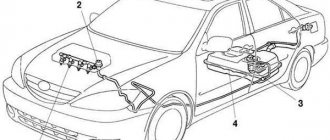Camry gas tank capacity
Reliability of vehicle operation depends on the fuel used.
Using low-quality fuel leads to serious problems. Modern electronic control units are capable of adjusting the power plant to the low-octane gasoline used by changing the ignition timing, which, however, entails increased wear of the power unit elements, as well as an increase in consumption. The volume of the gas tank is affected by the size of the car, the weight of the vehicle, and power. SUVs and trucks are equipped with more capacious gas tanks compared to sedans, station wagons, and minivans. Regardless of the size, the fuel tank requires regular maintenance.
The volume of the Camry tank and fuel consumption are determining and interrelated factors in the reliability of vehicle operation.
Machine configuration
On the Russian and European markets, the car is presented in several trim levels:
- Standard - has front and rear fog lights. Alloy wheels are installed, including on the full-size spare wheel. There is an electric power steering. The driver and front passenger seats are heated and the seats are upholstered in fabric. Full electrical accessories and parking radar are installed. The panel is decorated with wood-look inserts. There are many containers and small compartments for various items in the cabin.
- Standard plus - the package includes a rain sensor and a rear mirror with an auto-dimming function. The display on the center console is color.
- The Classic package includes leather seat upholstery. The front seats are electrically driven. The cabin has an air ionizer and cruise control.
- Comfort - in addition to the options listed above, there are headlight washers.
- Elegance - complemented by chrome-plated external door handles. Xenon optics have an auto-correction function.
- Prestige - the rear row seats are electrically adjustable and heated. The sound system control buttons are located on the steering wheel.
- Luxury - an electric steering column drive for reach and tilt angle has been added to the available options.
Camry XV10 gas tank capacity
The tank volume of the Toyota Camry XV10 is 70 liters. According to the requirements established by the manufacturer, the fuel used is AI-95 gasoline. Fuel with an octane rating of 95 is recommended for refueling Toyotas with an automatic transmission or manual transmission.
On a full tank, the Camry XV10 can travel about 540 km. This parameter is averaged and depends on the type of road, speed, driving style, and a number of other external factors. For example, fuel consumption of a 2.2 5S-FE with automatic transmission under ideal conditions should not exceed 11.2 liters. Actual consumption depends on weather conditions, the quality of the road surface, wear of the engine part, and so on. The appetite of the gasoline 3.0 3VZ-FE can reach 13.2 liters per hundred.
Cars with a manual transmission travel a longer distance with a full gas tank, unlike cars equipped with an automatic transmission. The reason for increased fuel consumption may be a failure of the sensor of the electronic engine control unit. In this case, the actual fuel consumption will not be displayed.
Let's sum it up
The standard engine capacity of the Toyota Camry V50 is 70 liters, which, according to the developers, is the optimal solution. Fuel consumption primarily depends on the type of road and engine power. Thus, the maximum distance can be driven on the highway, without frequent braking and turning.
Camry 40 is a car produced by the Japanese company Toyota, which is the most popular business class car in the CIS countries. The sixth generation of the Camry model was presented in 2006. It replaced the V30 (5th generation). And in 2007, the next year after the start of sales, this model became the car of the year in Russia.
Toyota Camry XV70
The type of fuel consumed by the XV70 is AI-92. The manufacturer recommends using gasoline with an octane rating of 92 to refuel the XV70 with any power unit. Fuel consumption in the urban cycle will be 9.7 liters if we are talking about 2.0. 11.5 liters are consumed per 100 km when the engine displacement is 2.5. 12.5 liters are spent per hundred with V6 3.5.
Gas tank - 60 liters.
A sharp increase in fuel consumption indicates a technical malfunction. Most often, the engine part, ignition elements, injectors or air filter are to blame. Often the problem is the fuel tank itself. To avoid leakage, manufacturers make multilayer tank walls, however, even in this case, the car owner is not 100% insured against leakage.
Most popular model
When talking about the Toyota Camry V40, it is worth considering all its technical nuances using the example of a specific model. And as such, it’s worth taking a car that has become very popular. This is a model with a 2.4-liter engine and a 5-speed manual transmission.
So, the engine is gasoline, its actual volume is 2362 cubic meters. Torque indicator - 224N.M, 16 valves. It accelerates to hundreds from zero in 9.3 seconds, and the maximum speed is limited to 205 km/h. Average fuel consumption per 100 kilometers is approximately 9.9 liters. The tank capacity, by the way, is 70 liters.
The body is long - 4815 mm. The wheelbase is 2775 mm, and the curb weight is 1520 kilograms. Ground clearance is 16 centimeters (a good indicator even for our roads). In general, in technical terms, the Camry 40 is a very good car. Its price, by the way, will now be about 600 thousand rubles. And it will be a car in good condition. Other models will cost differently - you need to find out and search separately.
Technical characteristics of Toyota Camry 8 (XV70)
The 8th generation Toyota Camry sedan (XV70 body), which went on sale on the Russian market in April 2021, is built on the basis of a new modular platform developed within the TNGA architecture. The power frame, made with extensive use of high-strength steels, provides the car with a low center of gravity, good handling and a high level of passive safety.
Fuel consumption according to passport
Factors declared by the factory for Camry of different generations are presented in the table.
| Generation | Engine volume, l | Transmission type | Consumption in the city, l/100 km | Consumption on the highway, l/100 km | Average, l/100 km |
| XV20 | 2.2 | 5-speed Mechanics | 12,2 | 6,9 | 10,5 |
| XV20 | 2.2 | 4-speed machine | 13,2 | 7,9 | 11,0 |
| XV20 | 3.0 | 4-speed machine | 15,7 | 8,3 | 14,0 |
| XV30 | 2.4 | 5-speed Mechanics | 11,7 | 6,9 | 8,6 |
| XV30 | 2.4 | 4-speed machine | 13,2 | 7,6 | 9,7 |
| XV30 | 3.0 | 4-speed machine | 15,7 | 8,3 | 11,0 |
| XV40 | 2.2 diesel | 4-speed machine | 10,5 | 8,5 | n.d. |
| XV40 | 2.4 | 5-speed Mechanics | 11,6 | 6,7 | 8,5 |
| XV40 | 2.4 | 6-speed automatic | 13,6 | 7,8 | 9,9 |
| XV40 | 3.5 | 6-speed automatic | 14,1 | 7,4 | 9,9 |
| XV50 | 2.0 | 6-speed automatic | 11,4 | 6,5 | 8,3 |
| XV50 | 2.5 | 6-speed automatic | 11,0 | 5,9 | 7,8 |
| XV50 | 3.5 | 6-speed automatic | 13,2 | 7,0 | 9,3 |
| XV70 | 2.0 | 6-speed automatic | 9,7 | 5,5 | 7,1 |
| XV70 | 2.5 | 6-speed automatic | 11,5 | 6,4 | 8,3 |
| XV70 | 3.5 | 8-speed automatic | 12,5 | 6,4 | 8,7 |
Fuel consumption Camry 40
The fuel consumption of the Toyota Camry 40 per 100 km with various power units and transmissions is shown in the infographics below.
On the highway, the Camry's fuel consumption differs from driving around the city, where the speedometer rarely shows significant speed.
A number of factors also affect fuel consumption:
- weather conditions and season, for example, in winter, fuel consumption is always higher;
- driving style;
- technical serviceability of the car.
Popular power units
Now we need to talk about what engines are installed under the hood of the Toyota Camry 40 models. The base engine is a 2.4-liter 4-cylinder with 167 horsepower. Interestingly, this unit is an evolution of the one that was installed on the previous generation version. However, in this engine the pistons were lightened and the compression ratio was increased. Accordingly, technical indicators have improved. This engine operates in tandem with a 5-speed manual transmission (there are versions with automatic transmission).
There is also a 6-cylinder engine. Its volume is 3.5 liters and its power is 277 horses. Models that have this engine under their hoods are equipped exclusively with a 6-speed automatic transmission equipped with a manual control mode. In addition, this engine features a timing chain drive. Models with this engine reach 100 km/h in just 7.4 seconds. The maximum is 230 km/h.
Gasoline selection
According to the manufacturer's recommendations, it is necessary to pour only AI-95 gasoline. Operating experience suggests that Camry 40 works great on both AI-92 and AI-98. Below is a table compiled according to surveys of car owners.
| Type of fuel | Percentage of car owners who prefer this type of fuel |
| AI-92 | 20-23% |
| AI-95 | 69-75% |
| AI-98 | 0.04 |
| Gas | 0.01 |
In addition to the octane number, there are a number of additional recommendations for refueling with gasoline:
- The use of leaded gasoline is prohibited, as this will damage the catalyst and power plant;
- refueling should not be done at a station where the fuel supply has just been replenished, since all the turbidity from the tanks will fall into the tank and clog the fuel filter;
- If persistent detonation, tripping or other symptoms of low-quality fuel appear, you must stop and drain it.
About the car
Indeed, in the vastness of our homeland, the Camry 40 has become very popular. It was because of this that it was decided to build a plant near St. Petersburg to produce this particular model.
In 2011, production ceased - the V40 replaced the V50 generation.
The car was produced only in a sedan body. And the model underwent only one modernization - in 2009. The car looks impressive - a chrome-plated radiator grille, foglight surrounds, a chrome strip above the license plate (but only above the rear one)... All this created a unique image. Moreover, this car sits on 215/60 R16 tires. The model has excellent drag (the coefficient is 0.28). The wheelbase of the sixth generation was increased by 5.5 centimeters, but the length did not change.
Now about the interior and interior equipment that the Camry 40 car boasts. The first thing you need to pay attention to is the steering column. It can be adjusted in both directions, allowing the driver to adjust the steering wheel the way he wants. The second point is 2-zone climate control. Provides a decent level of comfort. And six airbags, which are required even in the basic configuration. The car also has a CD changer (6 speakers and 6 discs).
Interestingly, there are also European and Arabic versions of the Camry 40. But they, unlike the standard ones, seem more clumsy and not so obedient on the roads.
Additional equipment includes cruise control, leather upholstery, electric front seats and even a navigation system with a touch screen (this option was added in 2009).
The interior has become much more spacious compared to cars of the previous generation. Interestingly, in the expensive configuration called “Premium” the rear sofa is divided (proportion: 40 x 20 x 40). And each part can be moved longitudinally and the back angle can be adjusted. In even more expensive configurations, the sofa is divided in proportions 60/40, so that the backrests can be completely folded. By the way, the trunk of the car can accommodate 535 liters of cargo.
Fuel tank volume
The volume of the fuel tank of Toyota Camry cars of 40 different configurations officially supplied to the CIS market is 70 liters. In cars with automatic transmission and 2.4-liter engines, this amount of fuel is enough to cover 700 kilometers in mixed mode, when the average consumption is 9.9 liters. Mechanics will allow you to drive more. In a car with a manual transmission, the driver will cover 850 kilometers before the next refueling. In a car with a 3.5-liter power unit and an automatic transmission, you can cover 700 kilometers on one gas tank, all other things being equal.
The Camry 2.4 G Four 4WD model is produced for the domestic Japanese market. This is an all-wheel drive version of the car. Due to the reduced amount of space in the rear of the car, tanks with a volume of 65 liters are installed on it.
The hybrid version has two types of tanks:
- volume 65 liters;
- capacity 65 liters.
History of development
The Toyota Camry fuel system operates using traditional technology. Fuel is supplied to the engine by a fuel pump directly from the fuel tank through a hose system running along the body. This was the case in the first Toyota Camry, and the same system remains in the latest versions.
The tank volume in these models has traditionally been 70 liters. According to Japanese engineers, this is the most optimal displacement option in terms of weight ratio, space occupied and distance covered. However, in the 90s, the automaker decided to experiment a little, and a 60.2-liter tank was installed on the cars. This can be seen on the 1990 and 1991 models. But then such a solution did not find positive reviews, and the manufacturer returned to the previous standard.
The auto giant released another option with a 60-liter tank in 2007. However, then this technical characteristic was justified by the fact that the car was equipped with a hybrid engine. By the way, such versions were not assembled in Russia and were not imported from Japan. What can not be said about the US and Australian markets, where hybrid versions were held in high esteem and were very popular.
Body and appearance
Thirty after restyling
The appearance is the personification of American automotive design of those years, which was characterized by smooth lines, rounded shapes and the obligatory presence of chrome on the radiator grille. The appearance of the 5th generation Camry fully corresponds to the philosophy of a comfortable, respectable business class car. Compared to the previous generation (XV 20), the body has significantly increased in size: in length by 50 mm, in height by 70 mm, and in width by 10 mm.
The only place where “bugs” can appear is the trunk lid near the chrome trim. In 2005, the car underwent minor restyling: the radiator grille and front bumper changed, and different headlights and taillights began to be installed.
What difficulties might the current owner encounter?
The chrome of the radiator grille is not durable, it does not like salts and reagents. Over time, on Toyota Camry 2001-2006. produced for the American market, the headlights become cloudy. This problem is solved by replacing the plastic protection with glass from the “European” thirty. The electric drives of the antenna and folding mirrors fail; cleaning the mechanisms will not help for long.
Camry 30 before restyling
Window regulators often break; the mechanism only needs to be replaced completely. The air conditioner has been on for a while, but it’s still hot – the fan, or rather its relay, has failed. The age and difficult conditions of use of the car will lead to radiator leaks, to delay this breakdown, wash the radiator once a year and change the antifreeze every 30 thousand km.
The front brake discs can easily wobble when driving through a puddle after hard braking; they often have to be changed every 30 thousand km. Every time you replace the pads, clean and lubricate the caliper guides; if this is not done, the mechanism may jam.
Camry 30 after restyling (spoiler is an attribute of the SE configuration)
XV55 interior
The interior of the car retains a massive front panel made of foam plastic. The steering column is equipped with adjustment for reach and installation angle, and there is an analog instrument cluster with bright blue backlighting. Additional information is displayed on the LCD screen. On the steering wheel there are buttons for controlling the radio and additional functions. The climate control unit is a push-button unit; some vehicles are equipped with an air ionizer with forced switching on and off.
There are separate seats for the driver and front passenger. Between them there is a console with an adjustable armrest. The seats are manually adjusted according to the distance from the pedals, the height of the cushion and the angle of the backrest. An electric heating system is included as standard equipment, the seats are upholstered in fabric or artificial leather (the type of material depends on the configuration).










